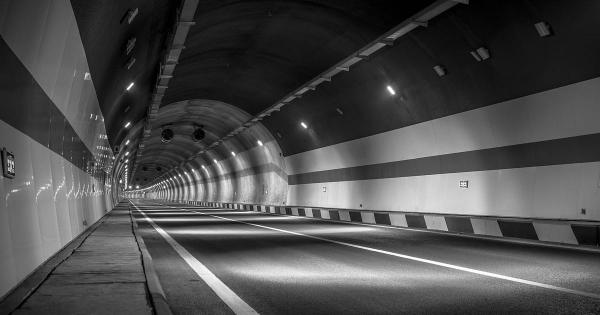
Vollständige Schliessung des Mont-Blanc-Tunnels für 21 Tage
Um die vollständige Erneuerung des Straßenbelags mit Instandhaltungsmaßnahmen an sämtlichen Fahrbahnoberflächen über die gesamte Tunnellänge zu ermöglichen, wird der Mont-Blanc-Tunnel von 17:00 Uhr am Montag, den 17. Oktober bis 10:00 Uhr am Montag, den 7. November komplett für den Verkehr gesperrt.
Konsultieren Sie die Karte mit den empfohlenen Alternativrouten.
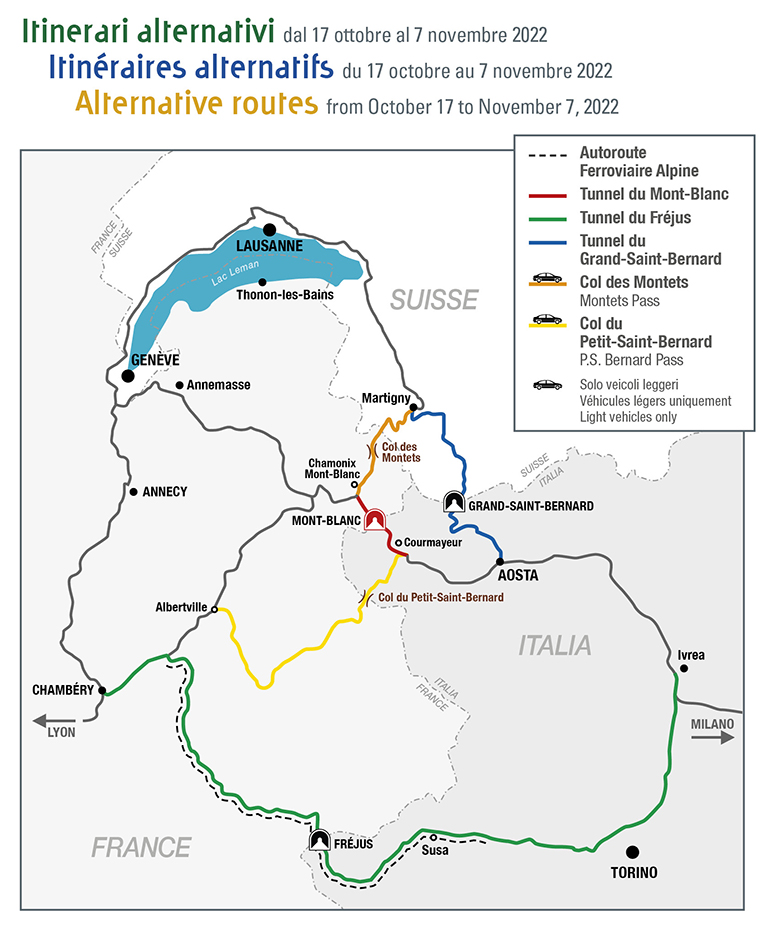
Quelle der Informationen und Grafiken: Tunnel Mont Blanc
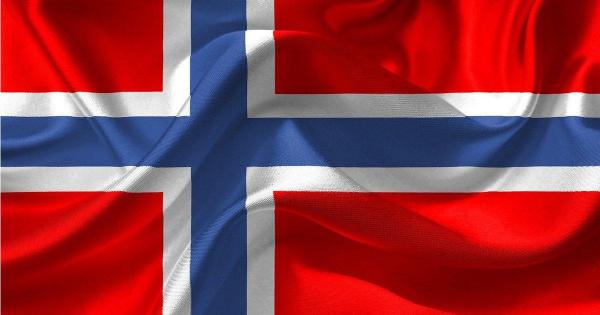
Norwegen übernimmt die Regeln des Mobilitätspakets ab dem 1. November
Obwohl Norwegen kein EU-Mitglied ist und nicht verpflichtet ist, diese Vorschriften einzuhalten, ist das Verkehrsministerium des Landes zu dem Schluss gekommen, dass das EU-Mobilitätspaket dazu beitragen wird, den Straßenverkehrssektor zu einem besseren Ort zum Arbeiten und Wirtschaften zu machen. Aus diesem Grund hat das Ministerium beschlossen, neue Vorschriften über Lenk- und Ruhezeiten für Fahrer, die Verwendung von Fahrtenschreibern in Fahrzeugen und die Regeln für den Zugang zum Beruf eines Kraftverkehrsunternehmers zu erlassen.
Die neuen Regelungen sind Teil des sogenannten Sozialteils des Mobilitätspakets, das am 18. März in das EWR-Abkommen aufgenommen wurde.
Die wichtigsten Regelungen, die am 1. November in Kraft treten:
⏺ Für den Betrieb von Kleintransportern über 2,5 Tonnen ist eine internationale Transportlizenz erforderlich. Transportunternehmen müssen auch andere Anforderungen erfüllen, wie z. B. Sitz im EWR-Raum, guter Ruf, ausreichende finanzielle Leistungsfähigkeit und fachliche Kompetenz.
⏺ Die Kabotageregeln gelten auch für den internationalen Transport mit Kleintransportern.
⏺ Fahrzeuge im internationalen Verkehr müssen alle 8 Wochen zu einer der Betriebsstätten in ihrem Mitgliedstaat zurückkehren.
⏺ Transportunternehmen müssen ihre Arbeit so zu planen dass der Fahrer in der Lage ist, wenigstens alle vier Wochen nach Hause zurückzukehren und eine regelmäßige wöchentliche Ruhezeit zu nehmen,
⏺ Fahrer dürfen ihre wöchentliche Ruhezeit nicht im Fahrzeug verbringen
⏺ Die Vergütung für Fahrer darf nicht davon abhängen, wie schnell die Waren geliefert werden.
⏺ Die Karenzzeit von 4 Tagen nach der letzten abgeschlossenen Kabotagebeförderung, während der ausländische Fahrzeuge keine Kabotagebeförderungen in Norwegen durchführen dürfen.
Änderungen gültig ab 2026:
⏺ Für Kleintransporter mit einem zGG von 2,5 bis 3,5 Tonnen, die im internationalen Verkehr eingesetzt werden, gelten die Regelungen zu Lenk- und Ruhezeiten
⏺ Kleintransporter mit einem zGG von 2,5 bis 3,5 Tonnen, die im internationalen Verkehr eingesetzt werden, müssen mit einem Fahrtenschreiber ausgestattet sein
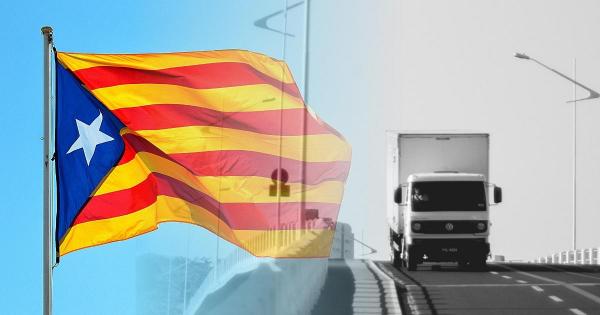
HGV restrictions in Catalonia
Owing to forecasts of significant increases in traffic volume on the 30th of September and 2nd of October, an additional restriction will be introduced on some road and motorway sections for vehicles or combinations of vehicles with a maximum authorised mass of more than 7.5 tons, which are required to use the right lane and must not overtake other vehicles and drive faster than 80 km/h.
On Friday, September 30, between 3:00 PM and 9:00 PM, the restrictions will apply on the following road sections:
➖ the AP-7 motorway, between KP 126, exit 12B at La Roca del Vallés, Granollers and the junction with the C-60 in La Roca del Vallés, and KP 172, exit 25 at Martorell and the junction with the A-2 in the Martorell commune;
➖ the AP-7 motorway in the territory of Terres de l’Ebre, where there are only two lanes, between KP 257, exit 35 at Vila-seca, Salou, Reus S. and Port Aventura, in the municipality of Vila-seca, and KP 344,8 the border between Tarragona and Castellón, in the municipality of Ulldecona.
On Sunday, October 2, between 3:00 PM and 10:00 PM, the restrictions will apply on the following road sections:
➖ the northbound AP-7 motorway, between KP 111.1, exit 11 at Sant Celoni and Montseny in the commune of Sant Celoni, and KP 133.8, exit 13 at Granollers, Montornès del Vallès and Vilanova del Vallés, in the municipality of Montornès del Vallès.
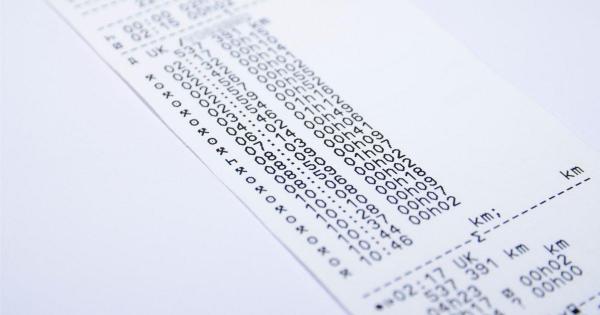
Frankreich – eine vorübergehende Ausnahme von den Lenkzeiten
Nach Streiks in Raffinerien der Ölkonzerne TotalEnergies und ExxonMobil sind mehrere Raffinerien geschlossen worden und der Betrieb einiger Kraftstofflager stark gestört.
In dieser Situation sind Straßentransporteure verpflichtet, verfügbare Kraftstoffvorräte von Import- oder Lagerorten, die weiter entfernt als üblich sind, zu Verteilerstellen zu transportieren, was Entfernungen und Fahrzeiten verlängert. Diese Situation hat insbesondere in Grenzgebieten zu Versorgungsproblemen und Spannungen an den Tankstellen geführt.
Es ist daher notwendig, den Straßentransport von Kraftstoffen im Land zu beschleunigen und vorübergehend zu erleichtern, um die verfügbaren Vorräte schneller zu verteilen und Engpässe zu vermeiden. Angesichts der Dringlichkeit des Problems hat die Regierung eine vorübergehende Ausnahme von der Lenkzeitregelung eingeführt:
1. die maximale tägliche Lenkzeit um eine Stunde überschritten werden darf;
2. die wöchentliche Höchstlenkzeit um höchstens vier Stunden überschritten werden darf.
Ausnahmen für Fahrzeuge, die Kraftstoff in Frankreich transportieren, gelten bis einschließlich Freitag, den 14. Oktober.
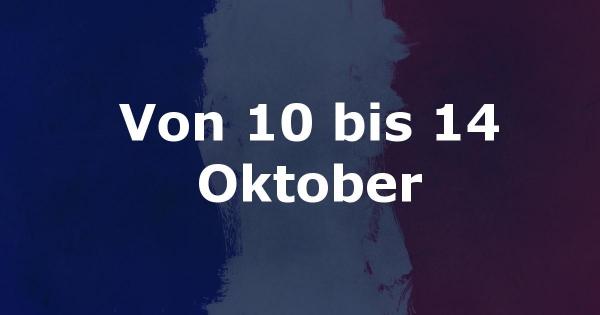
Nächtliche Sperrung des Mont-Blanc-Tunnels
Die Wartungsarbeiten am französischen Tunnel haben begonnen, und es wurde beschlossen, den Nachtverkehr zu ändern.
Um den Betrieb zu ermöglichen, wird der Verkehr im Mont-Blanc-Tunnel nachts vollständig unterbrochen:
– von Montag, 10. Oktober, bis Dienstag, 11. Oktober, von 22 Uhr bis 6 Uhr morgens,
– von Dienstag, 11. Oktober, bis Mittwoch, 12. Oktober, von 19.30 Uhr bis 6 Uhr morgens,
– von Mittwoch, 12. Oktober, bis Donnerstag, 13. Oktober, von 19.30 Uhr bis 6.00 Uhr,
– Donnerstag, 13. Oktober, bis Freitag, 14. Oktober, von 19.30 Uhr bis 6 Uhr morgens.
Quelle: Febetra

Germany: Exceptional exemption from the Sunday and holiday HGV driving ban for the transport of mineral oil and liquefied gas
The reason for the decision is the shortage of the inland waterway and rail transport capacities as well as the growing demand for fossil fuels.
The exemption has been issued by the Saxon Ministry of Transport to facilitate the transport of all types of mineral oil (heating oil/diesel/kerosene/petrol) and liquefied gas (butan/propane) within the Free State of Saxony. The purpose of the exemption is to maintain the functioning of supply chains in the energy sector.
The exemption is in effect from Sunday, September 18, until Sunday, January 1, 2023 and also applies to empty journeys directly related to transports mentioned above.

HGV restrictions in Catalonia
Owing to forecasts of significant increases in traffic volume on the 23rd, 25th and 26th of September, an additional restriction has been introduced on some road and motorway sections for vehicles or combinations of vehicles with a maximum authorised mass of more than 7.5 tons, which are required to use the right lane and must not overtake other vehicles and drive faster than 80 km/h.
The restriction on Friday, September 23, from 3:00 PM to 9:00 PM will apply on
➖ the AP-7 motorway, between KP 126, exit 12B at La Roca del Vallés, Granollers and the junction with the C-60 in La Roca del Vallés, and KP 172, exit 25 at Martorell and the junction with the A-2 in the Motoresll commune, from 5:00 PM to 9:00 PM;
➖ the AP-7 motorway in the territory of Terres de l’Ebre, where there are only two lanes, between KP 257, exit 35 at Vila-seca, Salou, Reus S. and Port Aventura, in the municipality of Vila-seca, and KP 344,8 the border between Tarragona and Castellón, in the municipality of Ulldecona, from 3:00 PM to 9:00 PM.
The restriction on Sunday, September 25, from 3:00 PM to 10:00 PM will apply on:
➖ the northbound C-32, between KP 114, at the junction 113 at Canet de Mar, in the municipality of Canet de Mar, and KP 84.5, at the junction with the B-20, in the municipality of Montgat.
➖ the northbound AP-7 motorway, between KP 111.1, exit 11 at Sant Celoni and Montseny in the commune of Sant Celoni, and KP 133.8, exit 13 at Granollers, Montornès del Vallès and Vilanova del Vallés, in the municipality of Montornès del Vallès;
➖ the southbound AP-7 motorway, between KP 158, where the B-30 joins the AP-7, in the commune of de Sant Cugat del Vallés, and KP 213 in the commune of Banyeres del Penedès, the fork junction AP-7 / AP-2
➖ the B-23, between KP 8, exit 8 at Sant Feliu de Llobregat and Molins de Rei Sud, in the municipality of Sant Feliu de Llobregat, and KP 15.5 on the B 23, at the junction with the AP-7, in the municipality of Castellbisbal.
The restriction on Monday, September 26, from 3:00 PM to 10:00 PM will apply on:
➖ the northbound AP-7 motorway, between KP 111.1, exit 11 at Sant Celoni and Montseny in the commune of Sant Celoni, and KP 133.8, exit 13 at Granollers, Montornès del Vallès and Vilanova del Vallés, in the municipality of Montornès del Vallès;
➖ the southbound AP-7 motorway, between KP 158, where the B-30 joins the AP-7, in the commune of de Sant Cugat del Vallés, and KP 213 in the commune of Banyeres del Penedès, the fork junction AP-7 / AP-2
➖ the B-23, between KP 8, exit 8 at Sant Feliu de Llobregat and Molins de Rei Sud, in the municipality of Sant Feliu de Llobregat, and KP 15.5 on the B 23, at the junction with the AP-7, in the municipality of Castellbisbal.
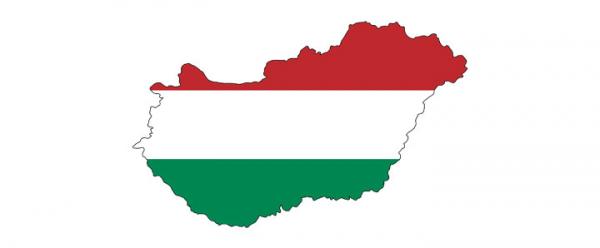
Hungary: toll increases to be introduced sooner than expected
The Association of Hungarian Road Hauliers (MKFE) has informed about an immediate amendment to the toll regulation, which was unexpectedly published in the Hungarian Official Journal on the night of September 19. As a result, the toll increase, previously planned to take place on January 1, 2023, will be brought forward.
MKFE emphasizes that the decree on toll increases was ameded without notifying representatives of the transport associations. On the basis of a preliminary but unofficial calculation, the toll increase corresponds to the rate of inflation in August, specified in the previous decree, but the increase will take effect in less than a month and not from the start of 2023.
What the transport sector finds disconcerting is the fact that the government’s decision will cause freight rates to go up, which will threaten the liquidity and profitability of transport companies.
In the case of contracts usually awarded in annual tenders, haulier costs are calculated by taking into all fees set out in applicable regulations; based on these calculations contracting parties determine freight rates which apply for the duration of a given contract. In the case of tolls, the calculation is based on the inflation adjustment introduced in 2020, which was used to calculate toll rates that are in effect in 2022. This regulatory framework has been replaced by the unexpected amendment, which will drive up hauliers‘ costs since October 1. These additional costs will have to be immediately included in their freight rates. That leaves much less time for companies to get ready than is usually the case. Independent experts estimate that a 15.6% toll increase will entail an immediate increase in freight rates by 3-4%.
The unexpected change in the conditions set out in the regulation is likely to undermine trust between customers and hauliers, which will be particularly detrimental to Hungarian hauliers that are struggling to compete in the international market. The unexpected toll increases are particularly damaging to micro, small and medium-sized hauliers, which often have no choice but to charge freight rates that are just above or even below their costs. Toll increases are bound to disrupt budgets planned for the current year and cause financial difficulties even in companies with much capital.
With transport costs constantly on the rise and driver shortages plaguing the transport sector, it is increasingly difficult to maintain the stability of supply chains. For this reason, representatives of the Hungarian transport industry are asking the government to support the sector by all possible means, e.g. by immediately introducing a system for reducing tolls for large hauliers, and by giving all domestic enterprises and sole proprietors the opportunity to pay tolls at a later date.
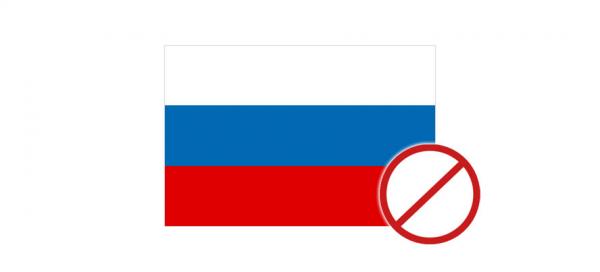
Der Kreml verbietet einigen westlichen Lkw den Transit durch Russland
Präsident Wladimir Putin unterzeichnete ein Dekret, das die russische Regierung ermächtigt Lkw von Fuhrunternehmen aus der EU, Großbritannien, Norwegen und der Ukraine den Transit durch Russland zu verbieten. Das Verbot gilt für alle Arten von Straßengüterverkehr: bilateral, Transit und von / nach Drittländern.
Das Verbot sollte nicht für die folgenden Situationen gelten:
1) ausländische Lkw, die ausländischen Spediteuren gehören und im Ausland registriert sind, die sich zum Zeitpunkt des Inkrafttretens des Dekrets auf dem Territorium Russlands befanden, sofern sie Russland innerhalb von 7 Tagen verlassen;
2) Transitbeförderung von Güter mit Lkw, die in das Land der Zulassung zurückkehren, vorausgesetzt, dass Fahrzeuge, die ausländischen Spediteuren gehören und im Ausland zugelassen sind, Russland innerhalb von 7 Tagen ab dem Datum des Inkrafttretens des Erlasses betreten und verlassen;
3) internationale Straßentransporte, die in der Liste der Ausnahmen aufgeführt ist,
5) internationale Straßentransporte mit einem Ausgangsort im Ausland und mit einem Bestimmungsort im Kaliningrader Gebiet und in der entgegengesetzten Richtung,
6) Umladen von Gütern auf russische oder weißrussische Fahrzeuge, sofern diese Spediteure über Genehmigungen für den vorherigen und / oder nachfolgenden Teil der Reise verfügen, und umgekehrt,
7) Ersatz des Anhängers / Aufliegers durch russische oder weißrussische Fahrzeuge, sofern diese Spediteure über Genehmigungen für den vorherigen und / oder nachfolgenden Teil der Reise verfügen, und umgekehrt,
❗Für Situationen, die oben unter 4-7 beschrieben sind, darf die Kraftstoffmenge ausländischer Lastwagen, die Russland verlassen, 200 Liter nicht überschreiten.
❗Für die unter 6 und 7 oben beschriebenen Situationen sind Ersatz und Umladung nur in ausgewiesenen Bereichen unter Zollkontrolle erlaubt. Diese befinden sich in:
– Oblast Kaliningrad (alle Stadtgebiete),
– Oblast Leningrad (Stadtbezirk Wyborg, Stadtbezirk Kingisepp),
– Oblast Murmansk (Stadt Murmansk, Stadtbezirk Pechenengky, Bezirk Kola, Bezirk Kandalaksha),
– Oblast Pskow (Stadt Pskow, Bezirk Sebesch, Bezirk Petschora, Bezirk Pytalowski),
– Republik Karelien (Stadtbezirk Kostomuksha, Bezirk Lakhdenpokhsky, Bezirk Loukhsky, Bezirk Sortavalsky),
– St. Petersburg.
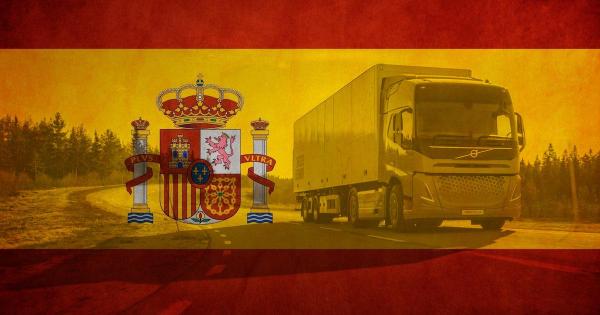
Katalonien – zusätzliche Beschränkungen für Lkw
In Anbetracht des prognostizierten Anstiegs des Verkehrsaufkommens am 7. und 9. Oktober sind auf einigen Straßen- und Autobahnabschnitte zusätzliche Beschränkungen eingeführt worden. Fahrzeuge oder Fahrzeugkombinationen mit einer zulässigen Gesamtmasse von mehr als 7,5 Tonnen müssen den rechten Fahrstreifen benutzen und dürfen andere Fahrzeuge nicht überholen und schneller als 80 km/h fahren.
Am Freitag, 7.Oktober, von 17:00 bis 21:00 Uhr gilt die Beschränkung auf:
➖ der Autobahn AP-7 zwischen KP 126, Ausfahrt 12B in La Roca del Vallés, Granollers und der Kreuzung mit der C-60 in La Roca del Vallés und KP 172, Ausfahrt 25 in Martorell und der Kreuzung mit der A-2 in der Gemeinde Martorell;
➖ die Autobahn AP-7 im Gebiet von Terres de l’Ebre, wo es nur zwei Fahrspuren gibt, zwischen KP 257, Ausfahrt 35 in Vila-seca, Salou, Reus S. und Port Aventura, in der Gemeinde Vila-seca, und KP 344,8 die Grenze zwischen Tarragona und Castellón, in der Gemeinde Ulldecona.
Am Sonntag, 9. Oktober, von 17:00 bis 22:00 Uhr, gilt die Beschränkung auf:
➖ die Autobahn AP-7 in Richtung Norden, zwischen KP 111,1, Ausfahrt 11 bei Sant Celoni und Montseny in der Gemeinde Sant Celoni, und KP 133,8, Ausfahrt 13 bei Granollers, Montornès del Vallès und Vilanova del Vallés, in der Gemeinde Montornès del Vallès.